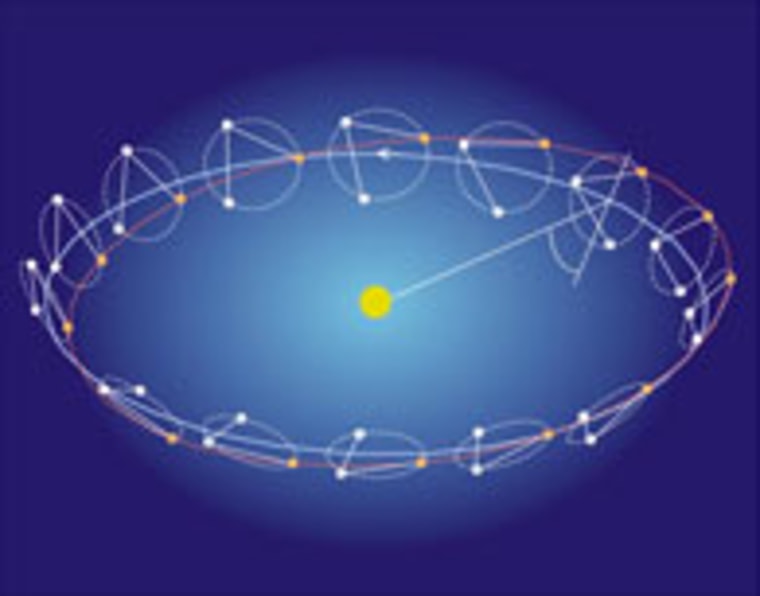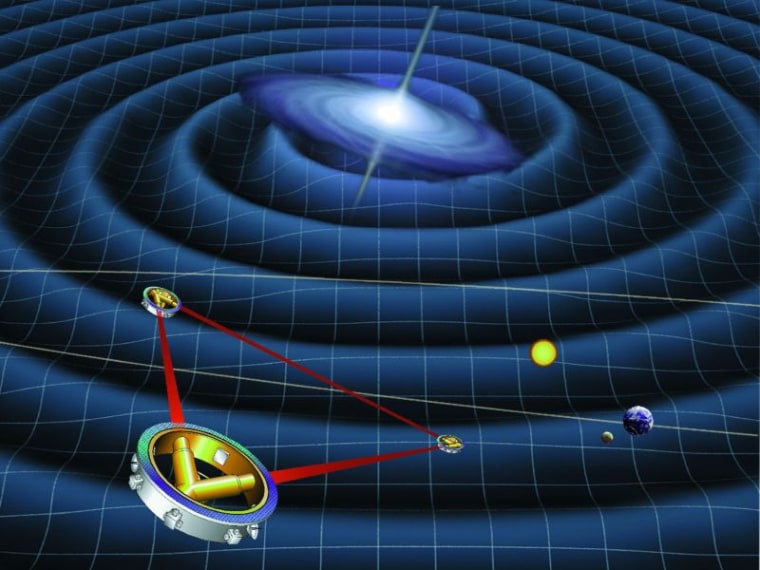April is proving to be the cruelest month for the Laser Interferometer Space Antenna (LISA), a major space mission to look for gravitational waves that was slated for launch around 2015. But news broke this week that NASA is abandoning funding for the project, which means the U.S. will cede its role in developing this critical instrument in order to redirect funds to the James Webb Space Telescope (JWST).
Sure, money is tight these days, and we need a replacement for the aging Hubble Space Telescope. It's still a sad, sad day for physics.
A brief recap on gravitational waves: Move a large mass very suddenly — or have two massive objects suddenly collide, or a supernova explode — and you would create ripples in space-time, much like tossing a stone in a still pond.
These waves were first predicted by Einstein's general theory of relativity in 1916. At the time, we didn't have the technology to detect them, since they are very weak and fade very quickly, although scientists found indirect evidence of their existence in observations of a binary pulsar — work that won the Nobel Prize in physics in 1993. But now we have the technology, and these gravitational waves should be detectable with very sensitive instruments.

One of these instruments is already up and running: the Laser Interferometer Gravitational Observatory (LIGO). As its name implies, LIGO is essentially a giant interferometer. There is a very large mirror hung in such a way as to form an arm, with two more mirrors hung perpendicular to it to form an L-shape. Scientists then pass laser light through a beam splitter, thereby dividing the beam between those two arms, and let the light bounce back and forth a few times before returning to the beam splitter.
LIGO has three such detectors, since it needs to operate at least two detectors at the same time as a control, so they don't get false positives. A passing gravity wave will cause ripples in space-time, which in turn will change the distance measured by a light beam; the amount of light falling on the strategically placed photodetector will vary slightly in response. The resulting signal will tell scientists how the light hitting the photodetector changes over time.
LIGO scientists liken the instrument to "a microphone that converts gravitational waves into electrical signals." LIGO hasn't reached its full sensitivity yet; that will happen once the planned upgrades for Advanced LIGO are complete.
Then there is LISA, which will take the search for gravitational waves into space itself, thereby escaping the random seismic noise of the Earth (which can interfere with detecting those very faint signals from gravitational waves). It's still a giant interferometer ... in SPAAAACE!
LISA would have placed three spacecraft in orbit around the sun, 3 million miles apart, flying in a triangle formation. When a gravitational wave passed by, the ripple would gently push the spacecraft around by an uber-tiny amount, yet still just enough to be detected by the ultrasensitive laser beams connecting the three spacecraft. The LISA website describes those beams as being "like a spider web made of beams of light."
If we already have LIGO, why do we need LISA? That's a good question, and one that Sean Carroll — who was a member of the "Beyond Einstein" road-map team that gave LISA the green light back before we had a budget crisis (*sigh* good times!) — has answered over at Cosmic Variance:
"Unlike LIGO, which strains as hard as possible and hopefully will detect something once it's upgraded, LISA would be bombarded with gravitational waves, and the trick will be picking out the interesting signals from above the ambient noise. (That’s a problem we don’t mind having.) ...
LISA’s science is not just achievable, it’s incredibly interesting. It would detect thousands of binary systems within our galaxy, as well as numerous inspirals of middleweight black holes into supermassive ones in other galaxies, giving us incredibly detailed access to the space-time metric near a black hole. As a side benefit, the wavelength is just right for looking at gravitational waves that might be produced in the early universe if the electroweak phase transition is especially violent."
But what's more alarming are the observations of Steinn Sigurdsson of Dynamics of Cats, who in a meticulous breakdown of the current budget battles points out that LISA isn't the only victim of NASA's budget ax: IXO, an X-ray satellite observatory, is also on the chopping block, and in recent years several other missions have been cut or canceled. We're left with four operating missions through 2014 and five in development — not all of which can be considered safe from future cuts — plus four others, including the JWST.
So, whole careers are thrown out the window, there are people who spent 10-20 years on the mission development — there is also very little left in the NASA pipeline, there could be just 1-2 operating missions by 2015, and a gap of several years before anything flies, depending on the budget they get, failure of current missions and developing missions keeping to their timeline. A lot of scientists are supported by the ... funding of these missions, and a lot of that is looking to go away.
We invested 14 years in LISA and now — poof! — it's gone. Is it the end of the world? Not likely. It's just one more step down the long road of decline, as the U.S. gets left behind in cutting-edge research and exploration.
Who knows? We could see a lot more scientists migrating to Europe, China and other countries that still value investment in science and technology.
